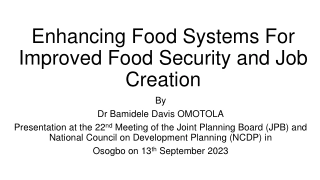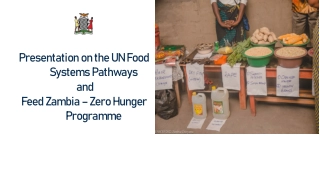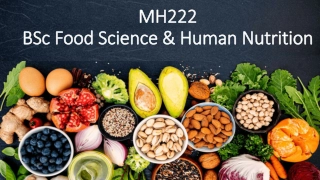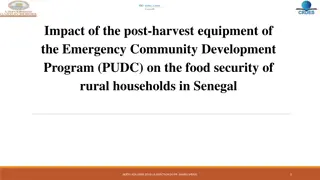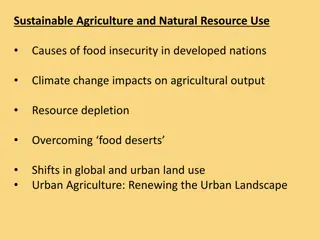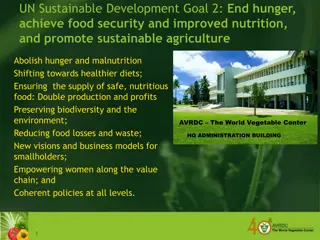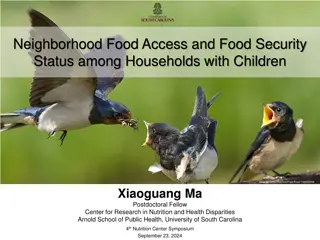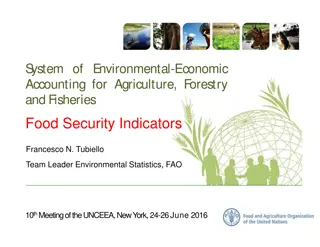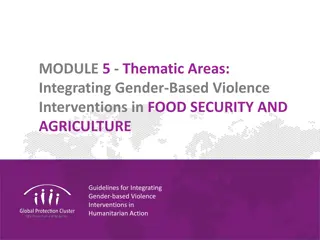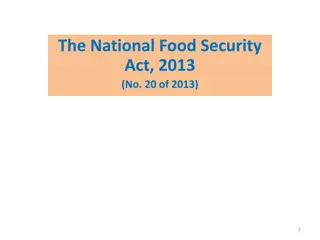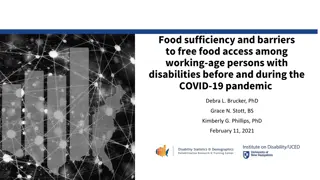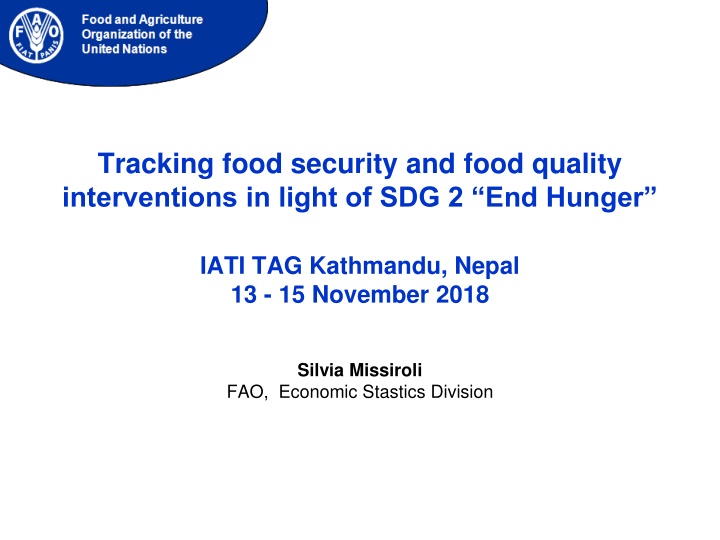
Enhancing Food Security Interventions for Sustainable Development
Addressing gaps in food security and quality interventions to achieve SDG 2: End Hunger. Insights from a conference in Kathmandu, Nepal, discussing strategies and challenges in tracking aid expenditures and classification.
Download Presentation

Please find below an Image/Link to download the presentation.
The content on the website is provided AS IS for your information and personal use only. It may not be sold, licensed, or shared on other websites without obtaining consent from the author. If you encounter any issues during the download, it is possible that the publisher has removed the file from their server.
You are allowed to download the files provided on this website for personal or commercial use, subject to the condition that they are used lawfully. All files are the property of their respective owners.
The content on the website is provided AS IS for your information and personal use only. It may not be sold, licensed, or shared on other websites without obtaining consent from the author.
E N D
Presentation Transcript
Tracking food security and food quality interventions in light of SDG 2 End Hunger IATI TAG Kathmandu, Nepal 13 - 15 November 2018 Silvia Missiroli FAO, Economic Stastics Division
Outline Background: FAO and IATI Gaps identified in CRS classification FAO proposal to OECD DAC to amend CRS classification FAO as an example of synergies between different kind of aid expenditures reporting Questions for you
Background: FAO and IATI Early 2016 Oct 2016 Dec 2016 April 2017 FAO joins IATI. Gaps in CRS classification identified. FAO inter-department IATI Task Team established. Gates funds FAO Statistics Division to improve Agriculture Statistics (quality, coverage, interoperability, open-ness). FAO publishes1000+ projects to IATI, including all the basic variables (i.e. CRS purpose, Policy Markers etc..). FAO quarterly publishes projects to IATI; Consult with internal experts, OECD, WFP, IFAD, nutrition NGOs about a proposal to OECD-DAC to amend CRS classification. 2017 Jan 2018 FAO submits the proposal to OECD-DAC. FAO quarterly publishes projects to IATI, refining elements and procedures. 3700 activities published. FAO reports ODA activities to OECD in June. 2018 3
Background: FAO and IATI IATI D-Portal: FAO main results
Gaps identified in CRS classification Project Manager comments on use of CRS codes I am also the LTO for a food safety project in Palestine .... However I could not see this on the list. absence of information While I agree that the project primarily relates to the health sector and thus is rightly coded to Sector 122, I consider this Food safety project having more to do with Infectious disease control than Nutrition. Thus in the absence of any Food safety purpose, I have proposed to change the Purpose code to 12250 (Infectious disease control). confusion
Gaps identified in CRS classification The magnitude of the gaps Food security (including food loss and waste) Food safety and quality $4.2 billion dollars, 1.1% of sector allocable aid (2013-2015). 42 donors 3,400 activities Identified across 97 purposes $0.3 billion dollars, 0.07% of sector allocable aid (2013- 2015). 30 donors 500 activities Identified across 39 purposes
GAPs identified in CRS classification It is not recommended to create a new purpose under Sector 520 DAC 5 CODE CRS CODE DESCRIPTION Current additional notes on coverage Developmental food aid/Food security assistance 520 Supply of edible human food under national or international programmes including transport costs; cash payments made for food supplies; project food aid and food aid for market sales when benefiting sector not specified; excluding emergency food aid. Report as multilateral: i) food aid by the EU financed out of its budget and allocated pro rata to EU member countries; and ii) core contributions to the World Food Programme. 52010Food aid/Food security programmes Objective: Propose CRS changes to OECD-DAC to fill SDG Goal 2- which aims to end hunger, achieve food security and improved nutrition, and promote sustainable agriculture.
FAO proposal to OECDDAC to amend CRS classification: Principles Followed (a) Minimize reporter burden (b) Ensure reporting feasibility (c) Ensure data relevance (d) Minimize structural breaks (e) Ensure alignment with recently accepted proposals (f) Ensure internal balance
FAO proposal to OECDDAC to amend CRS classification Revise Sector Code 430 (Other Multisector) Add new purposes in this revised sector 1. Food security policy and administrative management 2. Food safety and quality Ensure alignment with nutrition proposal
Fill gaps with new PURPOSES DAC 5 CODESECTOR PROPOSED CRS CODES PROPOSED DESCRIPTION PROPOSED COVERAGE Food security policy, programmes and activities; institution capacity strengthening; policies, programmes and activities for the reduction of food loss/waste; household food security programmes and activities; school feeding; food security information systems, data collection, statistics, analysis, tools, methods; coordination and governance mechanisms; other unspecified food security activities. Food safety and quality policies, programmes and activities, including food inspection and certification; strengthening food safety/quality capacities and development of standards along the value chain; monitoring/surveillance and laboratory capacities; and delivery of information, communication, education. Food security policy and administrative management Other multisector430XX 430 Food safety and quality Other multisector 430YY 430
Modify/clarify existing descriptions DAC 5 CODE CRS CODE DESCRIPTION Current additional notes on coverage 122 Basic health Direct feeding programmes (maternal feeding, breastfeeding and weaning foods, child feeding, school feeding); determination of micro-nutrient deficiencies; provision of vitamin A, iodine, iron etc.; monitoring of nutritional status; nutrition and food hygiene education; household food security. 12240 Basic nutrition Proposed additional notes on coverage Direct feeding programmes (maternal feeding, breastfeeding and weaning foods, child feeding, school feeding); determination of micro-nutrient deficiencies; provision of vitamin A, iodine, iron etc.; monitoring of nutritional status; nutrition and food hygiene . education; household food security. * What to do with the intervention that are removed? Create a NEW purpose code AAAA called Food security policy and administrative management and bring in school feeding and household food security to his new purpose code. * Proposal on Basic nutrition aligns with the proposal of Action Contre La Faim which was consulted with the SUN network
Other proposed changes Update coverage notes on Agriculture, Forestry and Fisheries purposes (not revised since 1999) A new policy marker for Food Security Add a set of SDG fields to allow the allocation of aid expenditures against a maximum of at least 3 SDG targets (withdrawn)
FAO as an example of synergies between different kind of aid expenditures reporting IATI Reporting (quarterly) OECD Reporting (yearly) FAO extra budgetary expenditures and Technical Cooperation (TCPs). FAO core budget expenditures on development assistance including TCPs. Programs (ODA), What do they have in common? They both require to classify expenditures according to the OECD-DAC Creditor Reporting System (CRS) classification They have a common part (TCPs projects) They are managed by the same people Possible synergies and integration
Questions for you Is it difficult to report food security and food safety interventions or other kind of aid activities? Can the proposed changes be useful for you? How relevant is a food security policy marker in your opinion? How can better synergies be obtained in diverse reporting at international level?
First version of FAO proposal to OECD can be found at: http://www.fao.org/3/BU481en/bu481en.pdf For more information, please contact: FAO Statistics Division Silvia Missiroli, Statistician: Silvia.Missiroli @fao.org Mukesh Srivastava, Team Leader of the Economics/Statistics Team: Mukesh.Srivastava@fao.org

